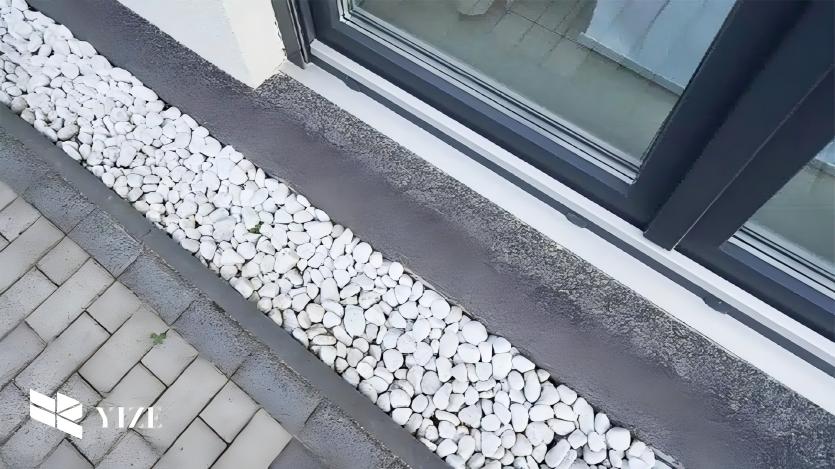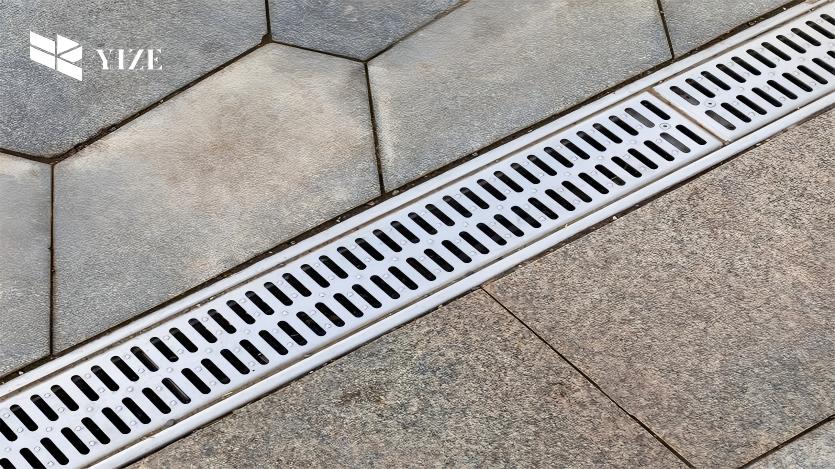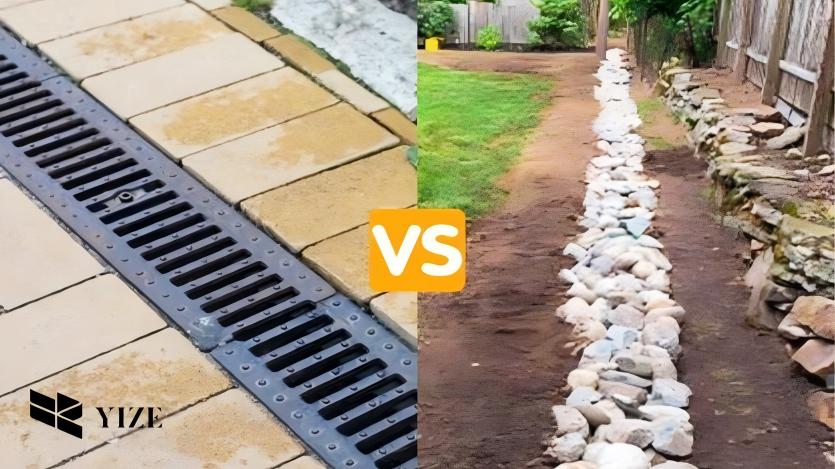
The proper management of excess water is a vital part of the protection of your property. Water can do a lot of damage to structures and supports, whether it comes from heavier rain or a bad drainage system. It results in long-term problems and expensive repairs. Proper water drainage systems are essential for properties to avoid damage and keep them in good condition. You need drainage systems to manage water on your property. There are two popular drainage system types: trench drains and French drains. The main function of both of these drains is to divert water from your land. However, their functionality and design are different. A French drain is made of a permeable geotextile material wrapped around a perforated pipe.
This French drain is set up in a trench filled with gravel below ground. The water goes through the line and into the gravel. The gravel soaks up the water and sends it away from the land. On the other hand, a trench drain is a channel that is both long and narrow. It’s usually placed in hardscaped places like driveways, patios, and walkways. Trench drains are made to collect and get rid of water from the ground before it can get into your home. There are pros and cons to both types of drainage systems, and which one you choose will rely on your property’s needs. This blog will talk about the differences between French drains and trench drains to help you choose the best one for your needs.
I. What is a French Drain?

French drains are a common way to deal with groundwater. Why? Because their purpose is to gather water and divert it away from your house. Water that builds up underground is called groundwater. It can damage your foundation, basement, or landscape. You may protect your property from groundwater damage by installing an Invisible French drain system, which collects and redirects the excess water. It helps in keeping your foundation strong as well.
The process of installing a French drain is pretty easy and doesn’t take too long. The system has a potential lifespan of several years with regular maintenance. It effectively protects against water damage and drains excess water. But French low profile shower drains need regular maintenance to eliminate silt, debris, and other clogs. This may cause water to flow more slowly. If Invisible French drains are not cleaned on a regular basis, they may clog, backing up water and perhaps causing flooding.
II. What is a Trench Drain?

Linear channel drains, or trench drains, are still another common choice for controlling water runoff. They are also a great option in some situations because of their many benefits. Trench drains collect and eliminate surface water before it damages your property. Installing trench drains is common in hardscaped areas like roadways, patios, and walkways, where water can easily pool on the ground. Trench side outlet shower drains help keep your home in good shape and stop expensive water damage. The drainage approach known as trench drains is quite flexible.
These linear channel drains are available in a range of sizes, such as 4-inch, 6-inch, and 8-inch channel packages. They are crafted from a variety of materials as well. You can easily find a trench drain that is great for your property because there are so many to choose from. The trench side outlet shower drain needs maintenance like any drainage method. The biggest problem with trench drains is that they get clogged. The channel can become clogged with leaves, trash, and other debris if it is not properly cleaned.
III. The Key Differences Between a French Drain and a Trench Drain

If you want to choose the best drain system, it will depend on your drainage needs and where it will be set up. The following are a few key differences between trench and French drains:
1. Objective
French drain:
The main purpose of a French low profile shower drain is to control groundwater or subsurface water. Its job is to move extra water away from places that are likely to flood. These places include low-lying portions of a garden or yard or building bases.
Trench Drain:
The purpose of a trench drain sometimes referred to as a channel drain or linear drain, is to control surface water runoff. It is usually put in places where there is a lot of water flow or rainfall. These places include driveways, patios, sidewalks, and parking lots. Trench side outlet shower drains are designed to collect and move water from the surface.
2. Design
French drain:
The standard design for an Invisible French drain is a trench filled with gravel and a perforated pipe running through it. The pipe is usually covered by a material liner to keep it from getting clogged. The holes in the pipe let water into the drain, which then takes the water away from the trouble area.
Trench drain:
A trench drain is a narrow, linear channel drain composed of metal or plastic. Its narrow, open top collects runoff from the surface and channels it into a drainage system. The goal of the design is to catch surface water before it can lead to damage or flooding.
3. Installation
French drain:
French low profile shower drains are usually invisible because they are installed underground. They require digging a hole, putting the perforated pipe inside, and then covering it with gravel or concrete.
Trench drain:
Trench drains are put in at or just below ground level, and they have an open grate or hole that can be seen on the floor. It’s easier to clean and fix them when needed.
4. Applications
French drain:
French drains help stop or lessen problems like basement floods, flooded yards, and groundwater seeping around buildings. French low profile shower drains work great in places where the dirt doesn’t drain well.
Trench drain:
It is possible for the trench side outlet shower to drain to handle large amounts of water. Because of this, they are often used in places where surface water control is important, like driveways, parking lots, and outdoor spaces that get a lot of rain.
IV. FAQs
Q1: What are the disadvantages of trench drains?
Trench drains need regular maintenance, just like any other type of drain system. If you don’t take care of the system properly, leaves and dirt can get stuck in it and make it less effective.
Q2: Can I install a French drain myself?
It is possible, but installing a French low profile shower drain takes a lot of digging and the right way to set it up to work well. It is best to talk to a professional to avoid making mistakes that will cost you a lot of money.
Q3: Are French drains a good option?
French drains are useful for managing water on your property, especially in rainy locations. This drainage system helps stop problems like water pools, soil erosion, and even floods in the basement. This Invisible French drain is useful because it diverts water away from potentially dangerous areas.
V. Conclusion
If you want to control the water on your property, both trench drains and French drains are good choices. When it comes to surface runoff, trench drains are great, but when it comes to maintaining your groundwater, Invisible French drains are the way to go. A French drain is the best option for your groundwater drainage system. But trench linear channel drains are the best way to deal with surface water in an open space. When it comes to controlling water flow, French drains and trench drains both work well. Which one is better relies on the needs of the project.
You should talk to a professional to figure out what the best solution is for your home. If you are looking for reliable, high-quality stainless steel drains or grates, Yzdrain is the business to contact. Yzdrain has a stainless steel trench drains and grate system for all of your requirements. We can also make custom, one-of-a-kind options for your project. Our goal is to supply you with highly advanced drainage systems. Our products are designed and made with great pride, paying close attention to every detail.
